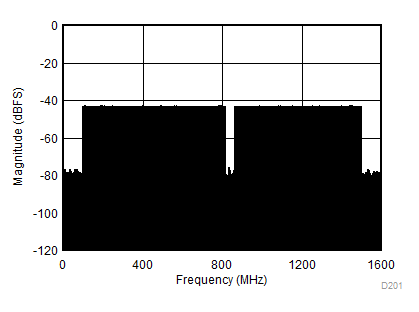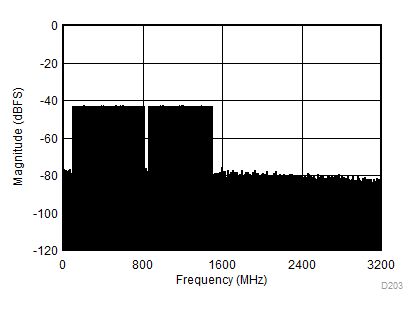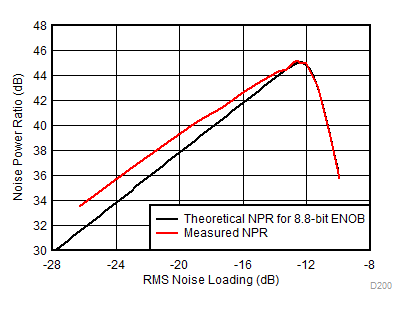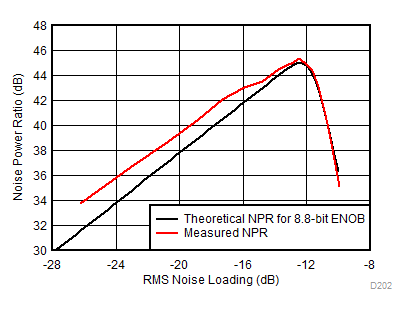The ADC12DJ3200QML-SP can be used in a number of different operating modes to suit multiple applications. Single-tone and two-tone performance is shown in detail in the Section 6 section. Noise-power ratio (NPR) is a performance metric that is often used to quantify performance of a wideband multi-channel receiver. These systems receive a large number of closely spaced signals that are uncorrelated. The summation of these uncorrelated signals forms a signal that looks like a normally (Gaussian) distributed noise source and NPR attempts to quantify performance for this type of signal. NPR measures the ratio of noise power in a notched band to the signal power in an equal size band. Figure 8-2 shows an example NPR measurement in dual-channel mode. The input signal spans from 100 MHz to 1.5 GHz and the notch is 45 MHz wide centered at a frequency of 839.7 MHz. The input power is swept to find the optimal RMS noise loading which is the input power where the NPR is at a maximum. The peak NPR, occurring at the optimal input power loading, becomes the desired operating point for wideband multi-channel receivers with normally distributed input signals. An input power sweep for dual-channel mode is shown in Figure 8-3 which shows the peak NPR of 45.2 dB occurring at the optimal loading of –12.6 dB relative to the peak (saturated) input power of the ADC. This peak NPR roughly corresponds to the performance of an 8.8-bit ADC, so the effective number of bits (ENOB) is 8.8 bits. Example measurements in single-channel mode are shown in Figure 8-4 and Figure 8-5. The signal generator output was limited to 1.5 GHz in order to achieve sufficient output power to saturate the ADC input for the single-channel mode measurement. The NPR calculation compensates for the limited signal bandwidth.

| JMODE 3 , fS = 3200 MSPS, signal band is 100 MHz to 1500 MHz, notch center frequency = 839.7 MHz, notch bandwidth = 45 MHz |

| JMODE 1 , fS = 6400 MSPS, signal band is 100 MHz to 1500 MHz, notch center frequency = 839.7 MHz, notch bandwidth = 45 MHz |

| JMODE 3 , fS = 3200 MSPS, signal band is 100 MHz to 1500 MHz, notch center frequency = 839.7 MHz, notch bandwidth = 45 MHz, peak NPR = 45.2 dB at noise loading of -12.6 dB |

| JMODE 1 , fS = 6400 MSPS, signal band is 100 MHz to 1500 MHz, notch center frequency = 839.7 MHz, notch bandwidth = 45 MHz, peak NPR = 45.4 dB at noise loading of -12.4 dB |



